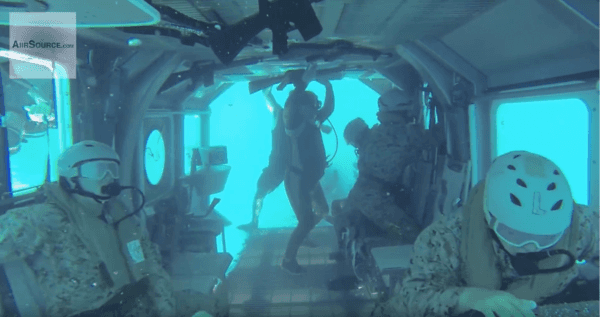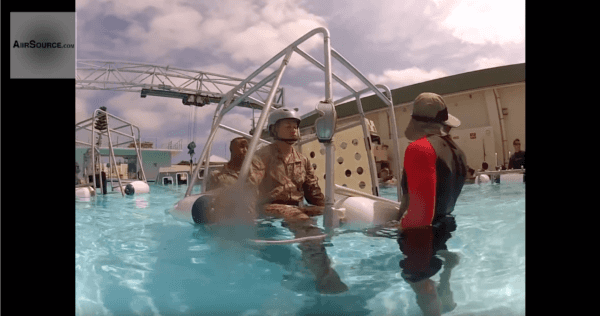U.S. Marines in training are often tasked with completing some of the most grueling simulations meant to mimic real-world life-or-death situations. And while training exercises may not cover everything a Marine could encounter during combat, the exercises usually include some of the most harrowing situations in order to ensure a Marine is prepared for anything.
In 2013, Marines of Combat Logistics Battalion 31, 31st Marine Expeditionary Unit experienced an intense underwater helicopter crash training session that included an upside-down escape in full gear.
The exercise was compiled on video by Sgt. Jonathan Wright and offers a glimpse of what it’s like training to be apart of the most elite military in the world.

Marines of Combat Logistics Battalion 31, 31st Marine Expeditionary Unit simulate an underwater helicopter crash during training. (AiirSource Military/YouTube)
In the video, trainees are strapped into a Modular Amphibious Egress Trainer (MAET), also referred to as a “helo dunker.” The generic fuselage is used to represent specific aircraft, amphibious vehicles, cockpits, and cabin emergency escape exits.
The MAET is pulled into the water and rotated upside down. The trainees are then tasked to safely escape by knocking out the windows and swimming through the relatively small gap. To make the simulation even more stressful, the recruits’ goggles are fogged out and allow for extremely limited visibility.
Divers stand by to assist anyone that might need help, but each of the Marines completes the task successfully.
See the simulation in action below:
In addition to the group MAET exercises, the Marines are also individually trained in single-person cages. This exercise also offers the Marines a chance to become comfortable being trapped upside down in the water. It also aids in getting the Marine familiar with an aircraft’s seatbelts and harnesses.
Donning their MARPAT uniforms, the trainees are also required to spend the day in the water. The additional weight of their uniform and boots adds yet another challenging element to the simulation.

Marines of Combat Logistics Battalion 31, 31st Marine Expeditionary Unit simulate an underwater helicopter crash during training. (AiirSource Military/YouTube)
The MAET provides Marines with an opportunity for advanced water survival training that was once only afforded to aircrews. It was first introduced at Camp Hansen in Okinawa, Japan in August 2002.
Two hours of classroom training on safety measures and techniques are required before a Marine ever enters the pool with the MAET.
A similar apparatus, the Submerged Vehicle Egress Trainer (SVET), was developed to simulate underwater escape from ground vehicles.



